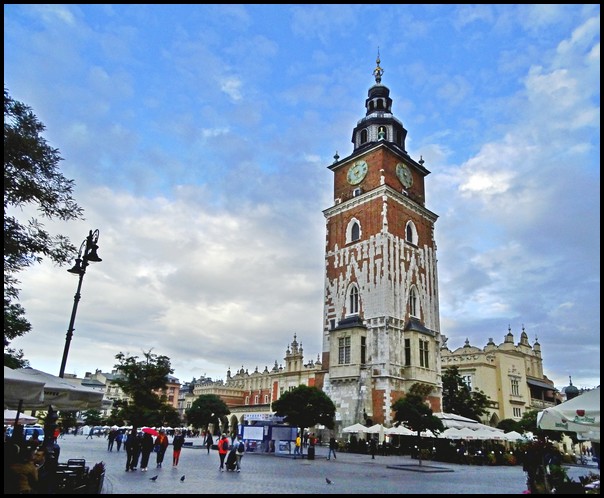 Introduction to Krakow – Poland
Introduction to Krakow – Poland
This September when I suddenly re-routed my travels up to Krakow, Poland in order to attend a recently-learned-about family reunion, I had no idea that I was about to visit one of Europe’s most magnificent historic cities, one of few that had miraculously survived WWII almost unscathed.
Since I had made my new plans at the last minute while traveling in Bulgaria and working on several luxury hotel reveiws, I had no time to do my usual research and pre-planning about Krakow. So when I arrived in Poland, I had no idea what a great treat was in store for me.
I quickly found out on my very first day in the city when I joined a Free Historic Walking Tour of Krakow’s old town. The tour was a fantastic way to start learning about Krakow’s long, complex history and start coming to grips with all the city’s important architecture, artworks, objects and special unique attractions.
In fact, I learned so much and enjoyed the tour so much that I joined three more free walking tours with the same company. I joined tours about the Jewish neighborhood and Jewish history in Krakow, about WWII in the city and a night walking tour about the city’s notorious historic mass murderers & other gory tales.
There are several companies in Krakow offering free walking tours. I took mine with Walkabout, simply because I found their brochure in a hostel. All the tour guides were great and very informative.
Before I get into all the amazing things to see & do in Krakow and why the city is so wonderful, here are some brief geographic and historic overviews of the city.
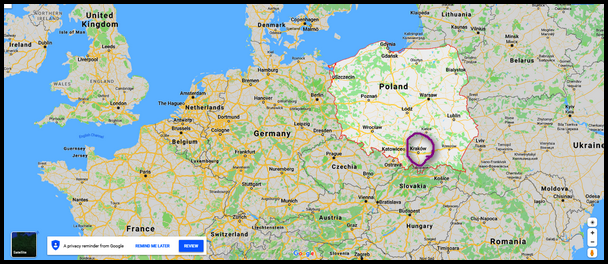 Location & Geography of Poland
Location & Geography of Poland
Poland is a relatively large country in Europe, just slightly smaller than Western Europe’s largest countries: Germany, France and Spain. Poland is also quite far north, with its northern border on the Baltic Sea and quite close to Denmark and Scandinavia. Poland is situated between Western Europe and Eastern Europe/ the former USSR countries.
Poland’s borders include Germany on the west, Czeck Republic on the southwest corner and Slovakia to the south. To the east of Poland are Lithuania, Belarus and Ukraine.
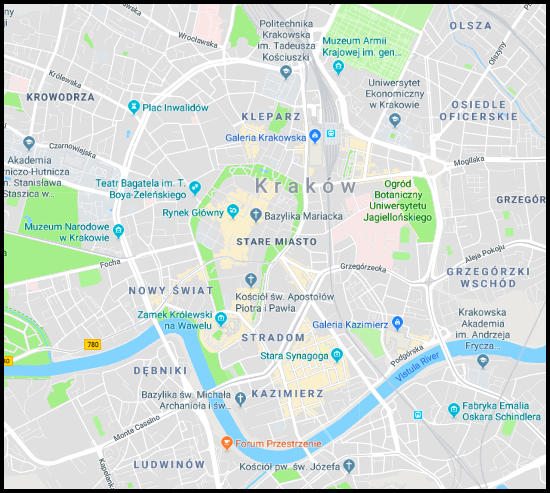 Location & Geography of Krakow
Location & Geography of Krakow
Krakow is located in southern Poland. It’s just two hours to the border of Czeck Republic and two hours to the high Tatra Mountains that form the border with Slovakia to the south.
Krakow is at roughly the same latitude as Prague, Czeck Repubic and Frankfurt, Germany. That puts Krakow further north than Paris, but further south than London. Krakow has a four-season climate with cold, snowy winters.
The city rests on the shores of the calm, wide, winding Vistula River. More specifically, Wawel Castle complex is set right along the river, perched on a very low hill at the southern end of the Old City, affording beautiful views over the Vistula both to the west and east.
Aside from Wawel Hill, Krakow is quite flat, great for cycling. The city is full of wide cycling lanes on roads & sidewalks, in parks and along the river. I saw heaps of people cycling around the city every day.
The entire city is quite large, modern and sprawling. But the most beautiful area, which is of most interest to visitors, is Krakow’s historic old town. That consists of an unsual tear-shaped city center that originally was an entirely walled, fortified city.
The stunning historic center is filled with cobblestone streets, dozens of huge churches, plazas large and small, and hundreds of well-preserved historic buildings. It was created over several centuries and, thus in different architectural styles.
The historic town formerly was surrounded by 3-meter-thick walls, dozens of tall watch towers and a moat. Now it is surrounded by a wonderfully shady park filled with soaring trees, walking paths, flower gardens with fountains, statues and monuments.
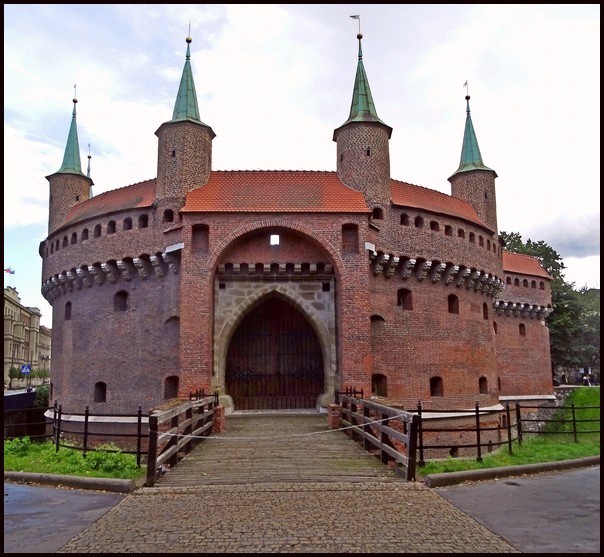 Krakow Points of Fame
Krakow Points of Fame
Here are some of the really noteworthy & important places & facts about Krakow:
Krakow served as capital of Poland for over 550 years – from 1038-1596. It was home to dozens of kings and royal families, making a ‘royal city’.
Krakow was historically one of the most important cities for international trade in Europe.
Krakow’s old town city square, ‘Rynak Glowny’, is Europe’s largest medieval city square (9.4 acres).
Barbicon Tower is the best-preserved medieval building of its kind in Europe.
Jagiellonski University is Central Europe’s 2nd oldest and one of the oldest surviving universities in the world.
Jagiellonski University is where Copernicus studied astronomy & other subjects.
Krakow is one of only 12 places in the world listed on UNESCO’s first 1978 World Heritage Sites List.
Krakow is one of the few European cities that survived nearly intact during WWII.
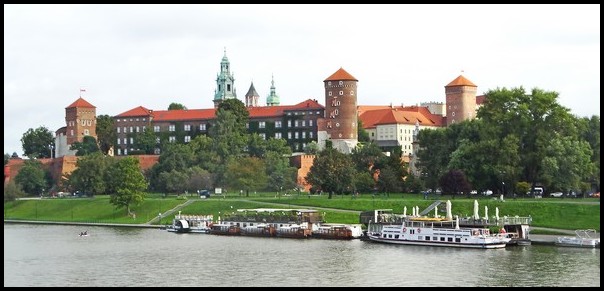 Brief Ancient History of Krakow
Brief Ancient History of Krakow
Like all the Balkan and European countries, Poland – and Krakow – have a very, very long and complex history that dates back several thousand years.
Krakow dates back to at least the 7th Century, several centuries before the Polish state existed. The first known settlement, dating back to th 4th C AD, was situated at Wawel Hill, which eventually became the site of Wawel Castle.
Over the centuries the city gradually expanded northward from the hill and was situated in several different empires, including the Vistulan, Moravian and Bohemian Empires that took over the area. By early 1000 AD, Krakow had become a very important center of international trade.
In the early1000s, Krakow became the capital of Poland and held that position for over 550 years – from 1038-1596.
In the 1200s Mongol raids completely destroyed the city twice. After that, the reigning king ordered Krakow to be completetly enclosed by tall, thick brick & stone walls to protect it against intruders. The walls around Krakow stood, successfully protecting the city from invaders, until the early 1900s when the current government ordered all but the northern section of wall to be demolished and the moat filled in.
Well before that happened, in the late 1700s and 1800s, the area now known as Poland was partitioned three times between Prussia, Russia and Austria. As a result, the country of Poland ceased to exist for 100 years. During that time, the Austro-Hungarian rulers moved the capital of their empire from Krakow to Warsaw, where the capital of Poland has remained to this day.
The historical details are considerably more complex than this. The main point I want to point out here is that Krakow today is a huge mesh of different cultural, architectural, culinary and intellectual influences. Secondly, throughout all the centuries of turmoil and re-positioning, Krakow always remained a very important and regal city.
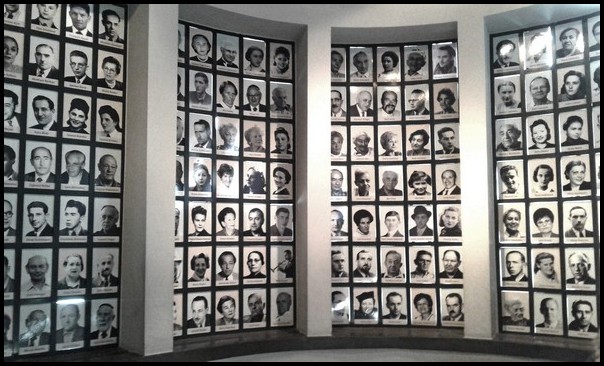 Brief Recent History of Krakow
Brief Recent History of Krakow
Poland sits right smack between Germany and what was the former USSR. Not surprisingly, then, the entire country was quite tragically embroiled in the midst of WWII.
In 1939, Krakow was once again taken over by another country when the Nazis invaded, installing Hitler’s right-hand man Franz into Wawel Castle. The Nazis proceeded to round up Jews and send them off to concnetration camps, particularly to Auschwitz, which is located just one hour from Krakow.
Curiously, while the Nazis emptied parts of Krakow of its residents, they did not destroy the city! This fact is still somewhat of a mystery to historians & politicians to this day. It’s theorized that perhaps Hitler was keeping Krakow as a back-up city to eventually live in.
For whatever reason, Krakow was spared destruction and thus remains one of Europe’s most beautifully-preserved historic cities.
Unfortunately for Krakow residents, immediately after Hitler was defeated and Nazi troops kicked out, the Russian Communists took over and forced Poland into a communist state. That lasted for 45 years, until 1989.
The fact that Krakow was in the middle of WWII and then under the communist regime adds other dimensions to the city. For visitors, Krakow has museums, tours, buildings and whole neighborhoods all relating to WWII and the communism era in Krakow.
Another important fact to point out is that modern Poland is actually quite a young nation! It’s been a democratic republic for just 30 years.
That’s long enough for one entire generation to have been born & raised in a democracy, with no personal experiences living under communism. On the other hand, a majority of Poles did live under the communism regime for at least part of their lives, and can remember it well.
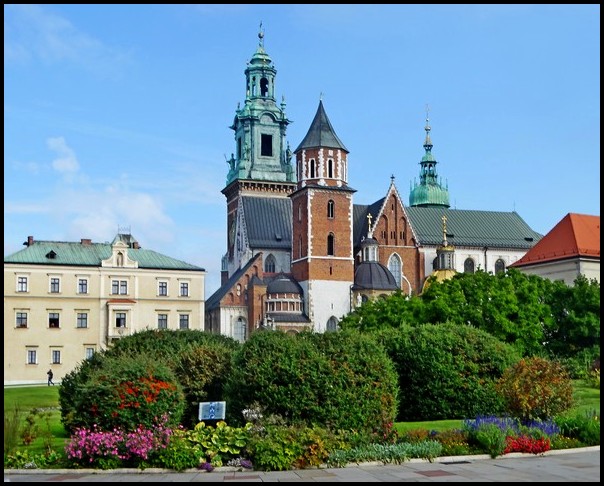 Best Things to See & Do in Krakow
Best Things to See & Do in Krakow
Because of Krakow’s very long & complex history, visitors can focus their time & energy on many completely different aspects of the city, depending on their interests. They could focus on the city’s amazing & diverse architecture, its plethora of museums, its dozens of churches & basilicas, WWII sites & history, the communist regime in Krakow or the city’s hundreds of restaurants & cafes & bars.
Regardless of one’s primary interest, however, most of Krakow’s best attractions are located in the historic old town and adjacent Jewish quarter. Since this part of Krakow is condensed in a relatively small, compact area, it’s quite easy to get from place to place and visit many things each day, for those so inclined.
There are already many great articles online about the best things to see and do in Krakow, some written by fellow travel bloggers who’ve visited the city. Krakow offers so many amazing things to see & do that it really does deserve an entire article – or two.
So here I’ll just briefly mention what I most enjoyed doing in Krakow, without going into too much detail, since I’d just be repeating what’s already out there online. For more detailed info, just do a google search and you’ll find dozens of articles to read.
However, I will be writing a post about 10 Free Things to See & Do in Krakow – coming up next week!
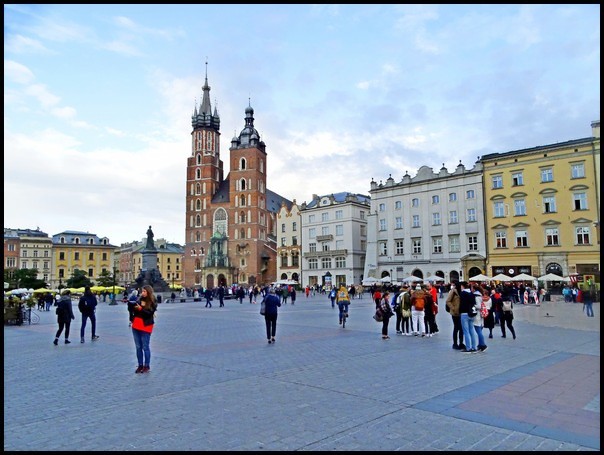
Meanwhile, here’s a list of what I most enjoying doing in Krakow for two weeks:
– Visit to Wawel Castle complex, including paid tours of the castle interior rooms
– Visit to Barbican Tower
– Wandering the streets of Old Town, admiring the architecture
– Watching hourly bugle players in St Mary’s Basilica bell tower in the main plaza
– Watching the large musical clock at Jagiellonski University-plays every two hours
– Visiting Ethnography Museum, Manngu Museum, University Museum and Jan Matejko House Museum
– Joining several free walking tours
– Entering various churches, cathedrals & basilicas to admire amazing architecture
– Circling Old Town by walking through the park surrounding the city
– Walking along Vistula River, especially across from Wawel Castle
– Photographing old town at different times of day
– Admiring the gorgeous horses & carriages
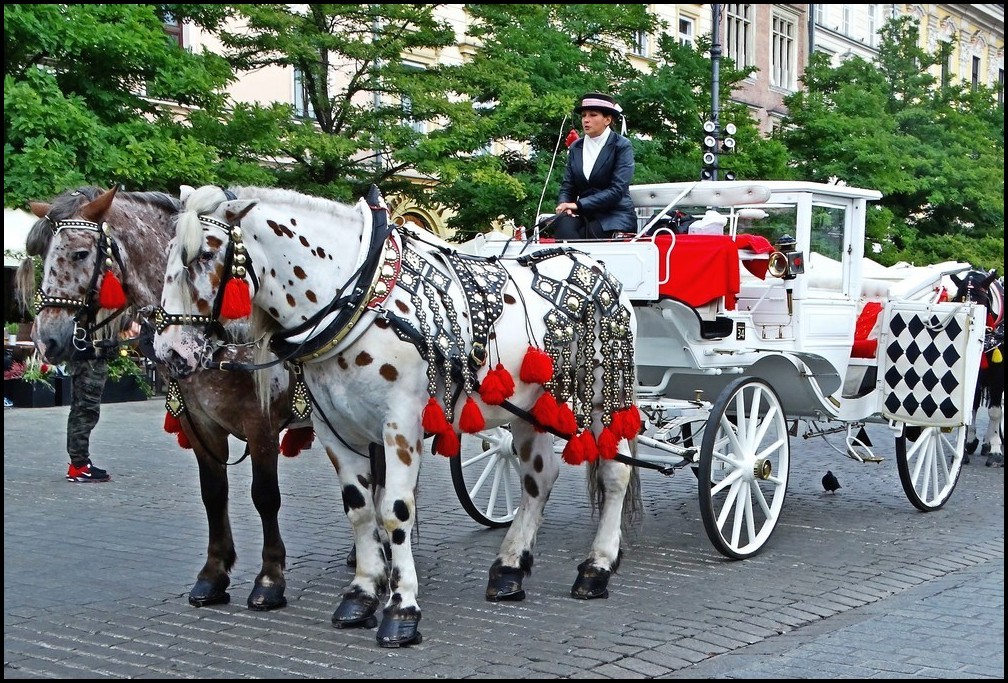 Costs of Budget Travel in Krakow – in brief
Costs of Budget Travel in Krakow – in brief
Quite wonderfully, Krakow – and Poland in general – are surprsingly inexpensive. The city is easily affordable for budget travelers.
I’m guessing the main reason it’s so inexpensive is that Poland doesn’t use the Euro. It uses its own currency, called ‘Zloty’. The exchange rate at my time of visit was basically $1 US = 4 Zloty / 1 Euro = 4.3 Zloty.
As a result, everything in Krakow and Poland seems to be really cheap when converted into the main currencies. For instance, typical dorm bed prices in/near old town are just $6-7 US!
Meals in nice cafeteria-style restaurants and pirrogue shops cost 3-5 Euro. Most of those large meals, for me, make two meals. Groceries, breads, cakes & other bakery items are quite inexpensive. A large loaf of bread costs about $1 US. Same for a large slice of fancy cake in a cafe.
Public transportation is also very cheap. A single bus or tram fare in central Krakow costs 1.70 Zloty / about $0.40 US for a 15-minute ride. Overland buses are also inexpenive. A 2-3 hour bus trip costs 5-6 Euro.
By staying in a hostel; cooking for yourself and/or eating at decent restaurants; walking and/or using buses & trams around the city; and minimizing costs on visiting attractions, a budget traveler can easily & comfortably explore Krakow for $15-20 US per day.
I have yet to work out my total expenses for my visit to Krakow, but that was the ballpark figure.
 Summary of Krakow
Summary of Krakow
Krakow is an utterly wonderful & beautiful city, often considered one of Europe’s best preserved historic cities. With its complicated history over many centuries, Krakow now offers a huge diversity of things to see and do, particularly in terms of architecture, museums and WWII history.
I really loved Krakow and hope to go back again to enjoy all the beautiful places one more time.
You might also enjoy:
===========================================================








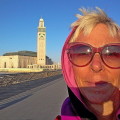
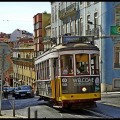

 Hi! I'm Lash, an American nomadic world traveler who's been traveling solo since 1998. I’m passionate about traveling the world nomadically and then sharing it all with you. I hope to inspire you to travel the world, to entertain you with tales from the road, and to help you reach your travel dreams. Welcome!
Hi! I'm Lash, an American nomadic world traveler who's been traveling solo since 1998. I’m passionate about traveling the world nomadically and then sharing it all with you. I hope to inspire you to travel the world, to entertain you with tales from the road, and to help you reach your travel dreams. Welcome! 




3 pings
10 Free Things to do in Krakow – Poland
2019/10/07 at 12:56 am (UTC 8) Link to this comment
[…] « Introduction to Krakow – Poland […]
introduction to Timisoara - Romania
2019/10/23 at 4:26 pm (UTC 8) Link to this comment
[…] Introduction to Krakow, Poland […]
Krakow Travel Guide – Flights, Hotels, Homes, Tours, Car Rentals – EbberTravels
2024/08/23 at 3:24 pm (UTC 8) Link to this comment
[…] more details on Krakow’s rich history and experiences, check out this Krakow travel guide. Visiting this fantastic city will give you memories that last a […]